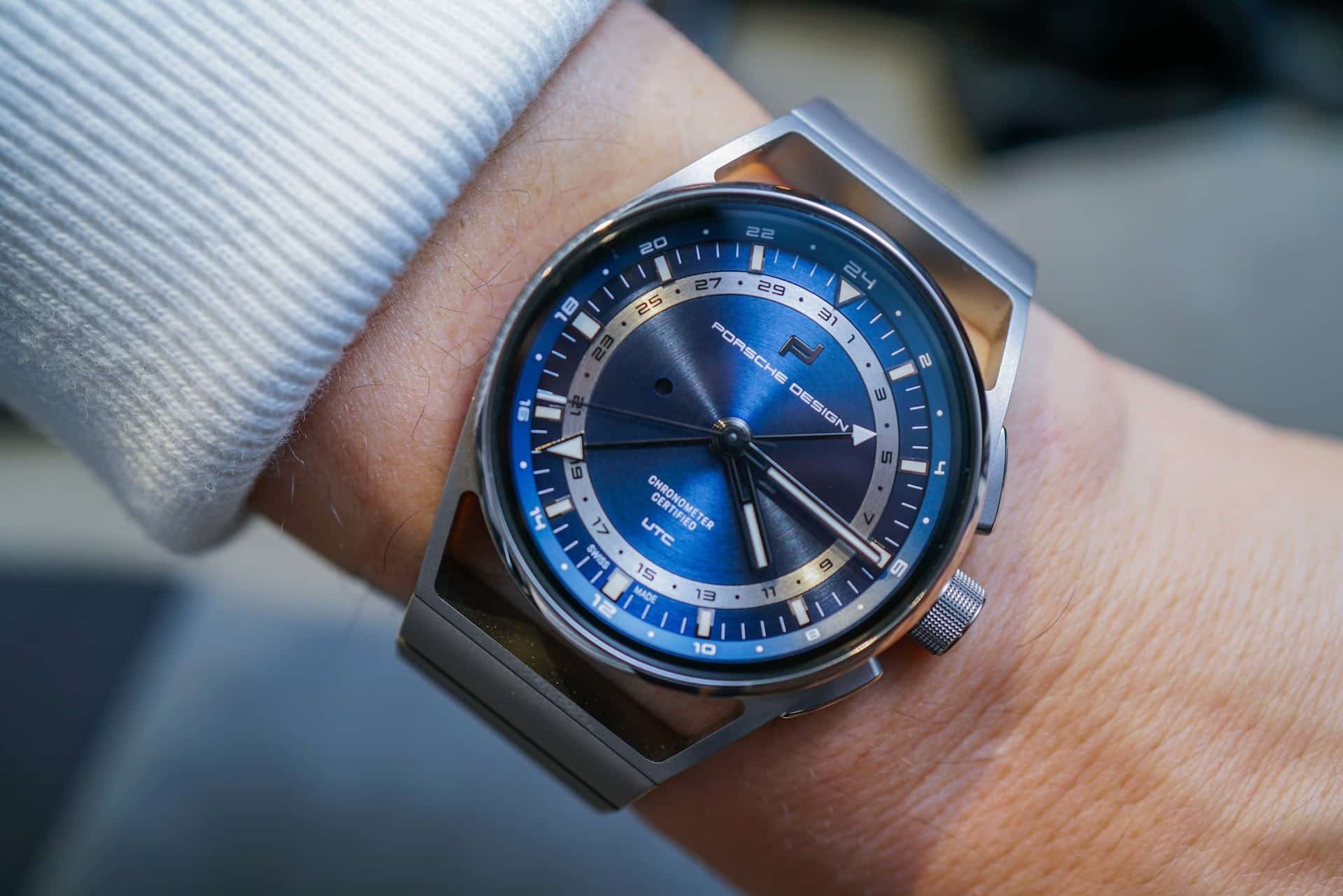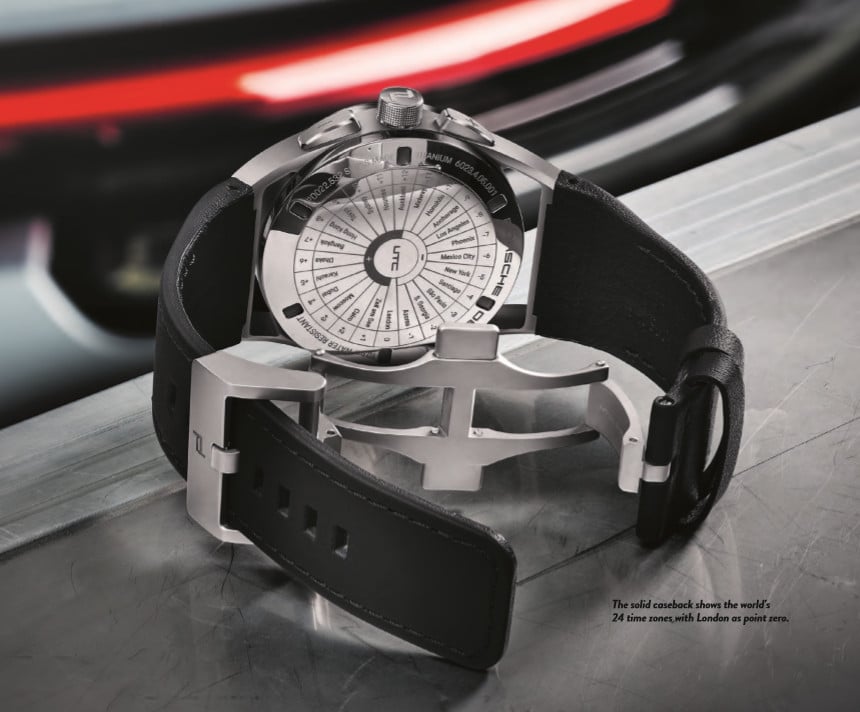At first glance the Porsche Design 1919 Globetimer UTC looks like a chronograph, with two pushers on the right side of the case. But here the pushers don`t activate a stopwatch but instead control a time-zone function. This is unique in the watch world. The Porsche principle has been integral ever since the founding of Porsche Design Timepieces AG in Solothurn, Switzerland, in 2014. Watch research, design and production are all under the company`s own control while consistently maintaining a direct link to the sports car manufacturer and the engineers at Porsche Motosport.
Caliber 04.110 is based on a Sellita SW200, with the addition of an exclusive Dubois Depraz module and distinctive Porsche Design finish.
This symbiotic relationship is often seen but has never been as clearly defined and direct as it is today. The first Porsche Design watch came onto the market in 1972 – the year Proffesor Ferdinand Alexander Porsche founded the Porsche Design lifestyle brand with the vision of extending the Porsche legend beyond the limits of the automobile. For the father of the 911, it was clear that based on the dashboard of the car, this watch had to be a chronograph with a black dial. And so the 1919 Globetimer UTC evokes the words of the renowned industrial designer: ‘’You have to use the know to consistently find the best new solutions.’’ Porsche Design`s engineer can convent a chronograph with a black dial into a timepiece with a world-time function while also transferring the technologies from the world of motorsport directly to the timepiece.
The former chronograph pusher on the right side of the case of the 1919 Globetimer UTC now operate the world-time function, so the hour hand showing the primary time can be changed with one quick click. If you travel into a different time zone, the hour hand can be adjusted forward by pressing the start-stop chronograph pusher at 2 o`clock (now engraved with a plus sign) or backward using the rest pusher at 4 o`clock (marked with a minus sign), depending on whether you are traveling east or west. The state-of-the-art trick here is that the date will advance in either direction while the central hand, indicating home time on the and from their unique connection to motor-sport, the time-zone control using two pushers was adapted from the paddle shifters on sports car steering wheels. And in addition, the Porsche engineers designed a smooth-shifting control, similar to those found in modern transmissions.
The Movement Runs Smoothly
This is no marketing gimmick – it`s clearly a technical transition from the world of motorsport to that of time measurement, shown by the complex changes made to the movement of the 1919 Globetimer UTC. The starting point is the now-widespread Sellita automatic Caliber SW200, which operates at a frequency of 4Hz and offers a (now rather meager) power reserve of 38 hours. In the version for the Porsche Design 1919 Globetimer UTC, this movement is chronometer-certified, the highest quality standard, and with its Glucydur balance and Nivarox 1 hairspring, it achieves rate results that deviate by no more than -4 seconds or +6 seconds per day. Both in our multi-week wearing test and when fully wound on the timing machine, the movement (known as 04.110 at Porsche Design) gained no more than 1 second per day. Once the power begins to deplete, the rate begins to be affected somewhat but still remains within the acceptable chronometer range at about -2 seconds.
Sophisticated Technology An exclusive module was created for the time-zone control in conjunction with movement specialist Dubois Depraz: two springs are held under tension beneath the right side of the case. Pressing a
pusher causes its spring to jump and with a rapid “click” that you can both feel and hear, the hand advances to the next time zone. This reflects the Porsche dual-clutch transmission in which the next gear is already selected. The effect is specifically designed to recall the paddle shifters on a sports car`s steering wheel and show that the next gear – or in this case, the next time
24-hour track around the edge of the dial, remains unchanged.
Time-zone Control Based on Motosport Design
Manufacturers such as Omega or Breitling control the time adjustment via the crown, which you have to pull out and turn in one direction or the other, possibly hitting the wrong position or accidentally misadjusting the time. Porsche engineers realized that this method wasn`t in line with Porsche design principles. But on the other hand, maybe Porsche engineers were the only ones who were able to control the time adjustment using what were formerly two chronograph pushers. From a historic standpoint, the first Porsche Design watch was a chronograph zone – has been engaged.
Black-and-White Contrast for Clarity
To ensure that the pushers typically used for Porsche Design chronographs could also be used for time-zone control, it was necessary to design an intermediate gear and modify the winding stem – in part so that all the operating elements along the right side of the Porsche Design titanium case would align perfectly.
The pointer date indication (which is also a newly designed modification to the Sellita base movement) advances forward and backward via a cam wheel to point to a steel date ring on the inner part of the dial. There are 12 applied hour markers along the edge that glow bright green inside the 1919 case, the timepiece reflects two worlds – Porsche Motorsport with a time-zone control that recalls the paddle shifters on a steering wheel the Porsche Design watch brand with expertise going back to 1972.
In the dark, along with the hands for the primary time indication and the tip of the 24-hour hand. Various widths and a triangle at 12 o`clock offer additional orientation – in line with the philosophy of Ferdinand Alexander Porsche, who said, “If you analyze the function of an object, its form often the black-and-white contrasts on the dial of the 1919 Worldtimer UTC and the perfect hand lengths above the matte black background (as In the Chronograph I form 1972) set the watch`s tone.
The dark dial is purposely designed to offer plenty of space for clear displays that are visible both day and night. And to ensure clarity for the wearer, a tiny window at 9 o`clock indicates the time of day while for day, black for night.
As we`ve come to expect from Porsche Design, the displays are surrounded by a 42-mm titanium case that gives the impression of a shiny container sitting inside a brush-finished bluckle. The complexity of the main portion of the case in presented without a bezel. A hard-coated sapphire crystal with seven-layer anti-glare treatment covers the dial, and solid threaded case-back seals the case and ensures a pressure resistance of 10 bar.

Even though there is no view of the movement, a finely engraved caseback with city names provides information on the world`s 24 time zones, based on the Coordinated Universal Time (UTC) that gives the watch its name. Wherever travel may take you , you`ll always know how many “clicks” you need to set the new zone. London designates point zero. The town of Zell an See, Austria, representing central European time (UTC + 1), is a discreet reference to the location of the Porsche Design Studio.
The Perfect Click Sound
If you want to use the 24-hour hand for a second time zone, it`s necessary to pull the crown out fully to adjust the hands. Then use the pusher to set the primary hour hand to home time. Not terribly complicated, but the careful – the seductive click sound may tempt you to play with it and end up with the wrong setting. In the hand-adjustment position there is a convenient, modern hack mechanism to facilitate setting the time precisely. Pulling out the crown to the middle position and turning it clockwise allows for quick date setting, but this can also be accomplished with a pusher when adjustment of only a day to two is needed. The pushers are load tested 10,000 times, so you can use them for more than just the occasional time-zone change. During our test we were tempted more than once to try out the pushers. They are a great feature of the watch. And if you allow the pusher to return to its starting position very slowly, you can sense the tension of the springs beneath the case. Once all the necessary settings have been completed, the crown can be screwed securely back in place.
Designed for Larger Wrists The glass-bead-blasted midsection blends smoothly with the openwork lugs, whose design reflects the Porsche lightweight construction principle and have been a part of Porsche Design since 2007 Worldtimer. A black leather strap attaches to the highly curved lugs. Cleverly integrated reinforcements at the connection points mean that the 1919 Globetimer UTC fits larger-sized wrists especially well but is less suited to smaller wrist size. The sturdy titanium claps easily opens on two sides with push buttons and the loose end of the strap is held in place with a wide prong. Now there`s nothing standing in the way of a trip around the world where a single click transports a traveler into another time zone, in terrific Porsche Design style.
SPECS
Porsche Design 1919 Globetimer UTC Titanium & Black
Manufacturer:
Porsche Design Timepieces AG, Biberststrasse 18, 45000 Solothurn, Switzerland
Reference number: 4046901979133
Functions: Hours, minutes, central sweep seconds, pointer date, time-zone function via hour hand and additional 24-hour hand, day-night display.
Movement: Porsche Design 04.110 based on Sellita SW200, automatic, COSC certified, Dubois Depraz module, 28.800 vph, 26 jewels, Nivarox 1 hairspring, Glucydur balance, eccentric fine regulator, 38-hour power reserve, Incaloc shock absorption, diameter = 28.5 mm, height = 6.94 mm







